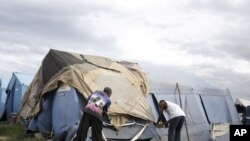Forecasters warn that the remnants of Tropical Storm Emily could reform into a tropical cyclone as the storm moves over Cuba and the Bahamas.
Emily broke up Thursday as it passed over the mountains between Haiti and the Dominican Republic, but the U.S. National Hurricane Center said Friday there is a 60 percent chance the remnants will regenerate into a more powerful storm.
Forecasters said the lingering elements are already producing strong thunderstorms as they move northwest, approaching Cuba and the southern Bahamas.
On Thursday, Emily dumped heavy rain on parts of Haiti and the Dominican Republic.
In Haiti's central Artibonite Valley, homes were inundated with mud and water, forcing some residents to evacuate. There are also concerns that rain-swollen rivers could still flood their banks, causing more damage.
In Port-au-Prince, hundreds of thousands of people are still living in tent cities after a devastating earthquake last year left the capital city in ruins. Haiti's tent cities perched on hillsides are vulnerable to storms, because much of the landscape has been stripped bare of trees, which have been cut down for use as fuel or building materials.
A slow-moving storm in June caused mudslides and flooding that killed at least 28 people.
The U.S. National Weather Service said Thursday that the rest of the Atlantic hurricane season is expected to be unusually active, with three to five storms expected to become major hurricanes.
The season runs from June 1 to November 30.
Forecasters Warn Emily Still a Threat










